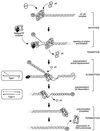Phi29 family of phages
- PMID: 11381102
- PMCID: PMC99027
- DOI: 10.1128/MMBR.65.2.261-287.2001
Phi29 family of phages
Abstract
Continuous research spanning more than three decades has made the Bacillus bacteriophage phi29 a paradigm for several molecular mechanisms of general biological processes, such as DNA replication, regulation of transcription, phage morphogenesis, and phage DNA packaging. The genome of bacteriophage phi29 consists of a linear double-stranded DNA (dsDNA), which has a terminal protein (TP) covalently linked to its 5' ends. Initiation of DNA replication, carried out by a protein-primed mechanism, has been studied in detail and is considered to be a model system for the protein-primed DNA replication that is also used by most other linear genomes with a TP linked to their DNA ends, such as other phages, linear plasmids, and adenoviruses. In addition to a continuing progress in unraveling the initiation of DNA replication mechanism and the role of various proteins involved in this process, major advances have been made during the last few years, especially in our understanding of transcription regulation, the head-tail connector protein, and DNA packaging. Recent progress in all these topics is reviewed. In addition to phi29, the genomes of several other Bacillus phages consist of a linear dsDNA with a TP molecule attached to their 5' ends. These phi29-like phages can be divided into three groups. The first group includes, in addition to phi29, phages PZA, phi15, and BS32. The second group comprises B103, Nf, and M2Y, and the third group contains GA-1 as its sole member. Whereas the DNA sequences of the complete genomes of phi29 (group I) and B103 (group II) are known, only parts of the genome of GA-1 (group III) were sequenced. We have determined the complete DNA sequence of the GA-1 genome, which allowed analysis of differences and homologies between the three groups of phi29-like phages, which is included in this review.
Figures







Similar articles
-
Molecular phylogeny of phi29-like phages and their evolutionary relatedness to other protein-primed replicating phages and other phages hosted by gram-positive bacteria.J Mol Evol. 1999 Feb;48(2):197-208. doi: 10.1007/pl00006458. J Mol Evol. 1999. PMID: 9929388
-
In vivo DNA binding of bacteriophage GA-1 protein p6.J Bacteriol. 2007 Nov;189(22):8024-33. doi: 10.1128/JB.01047-07. Epub 2007 Sep 14. J Bacteriol. 2007. PMID: 17873040 Free PMC article.
-
Terminal protein-primed amplification of heterologous DNA with a minimal replication system based on phage Phi29.Proc Natl Acad Sci U S A. 2011 Nov 15;108(46):18655-60. doi: 10.1073/pnas.1114397108. Epub 2011 Nov 7. Proc Natl Acad Sci U S A. 2011. PMID: 22065756 Free PMC article.
-
Protein-Primed Replication of Bacteriophage Φ29 DNA.Enzymes. 2016;39:137-67. doi: 10.1016/bs.enz.2016.03.005. Epub 2016 May 12. Enzymes. 2016. PMID: 27241929 Review.
-
Implication of the prohead RNA in phage phi29 DNA packaging.Biochimie. 2002 Sep;84(9):945-51. doi: 10.1016/s0300-9084(02)01444-x. Biochimie. 2002. PMID: 12458086 Review.
Cited by
-
Sophisticated modeling uncovers atomic DNA structure in bacteriophage φ29 cavity.Biophys J. 2013 May 7;104(9):1840-1. doi: 10.1016/j.bpj.2013.03.043. Biophys J. 2013. PMID: 23663824 Free PMC article. No abstract available.
-
Relevance of UP elements for three strong Bacillus subtilis phage phi29 promoters.Nucleic Acids Res. 2004 Feb 18;32(3):1166-76. doi: 10.1093/nar/gkh290. Print 2004. Nucleic Acids Res. 2004. PMID: 14973248 Free PMC article.
-
Duality of polynucleotide substrates for Phi29 DNA polymerase: 3'-->5' RNase activity of the enzyme.RNA. 2008 Mar;14(3):503-13. doi: 10.1261/rna.622108. Epub 2008 Jan 29. RNA. 2008. PMID: 18230765 Free PMC article.
-
Complete Genome Sequence of vB_BveP-Goe6, a Virus Infecting Bacillus velezensis FZB42.Genome Announc. 2018 Feb 22;6(8):e00008-18. doi: 10.1128/genomeA.00008-18. Genome Announc. 2018. PMID: 29472321 Free PMC article.
-
Bacterial Cell Display as a Robust and Versatile Platform for Engineering Low-Affinity Ligands and Enzymes.Chembiochem. 2020 Oct 1;21(19):2844-2853. doi: 10.1002/cbic.202000203. Epub 2020 Jun 29. Chembiochem. 2020. PMID: 32413179 Free PMC article.
References
-
- Abril A M, Marco S, Carrascosa J L, Salas M, Hermoso J M. Oligomeric structures of the phage φ29 histone-like protein p6. J Mol Biol. 1999;292:581–588. - PubMed
-
- Abril A M, Salas M, Andreu J M, Hermoso J M, Rivas G. Phage φ29 protein p6 is in a monomer-dimer equilibrium that shifts to higher association states at the millimolar concentrations found in vivo. Biochemistry. 1997;36:11901–11908. - PubMed
-
- Abril A M, Salas M, Hermoso J M. Identification of residues within two regions involved in self-association of viral histone-like protein p6 from phage φ29. J Biol Chem. 2000;275:26404–26410. - PubMed
-
- Anderson D L, Bodley J W. Role of RNA in bacteriophage φ29 DNA packaging. J Struct Biol. 1990;104:70–74. - PubMed
Publication types
MeSH terms
Substances
Grants and funding
LinkOut - more resources
Full Text Sources
Other Literature Sources

